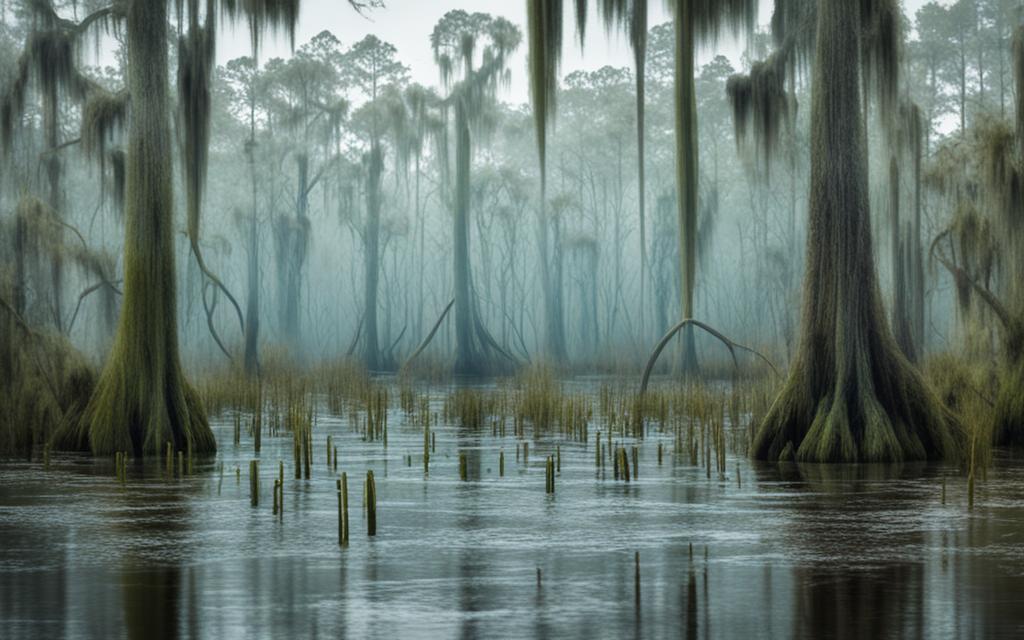The Florida wetlands, especially the Everglades, are full of unique natural wonders. Among these, gatorcountry swamp gas stands out. It’s not often talked about, but it’s a big deal in certain circles, like at GatorCountry.com. This gas, coming from the wetlands, is key to what makes the area special.
The Mystique of Swamp Gas in the Florida Everglades
The formation of swamp gas, especially methane, in the Florida Everglades is fascinating. It happens when organic matter breaks down without oxygen, leading to methane emissions. Swamp methane is vital for the balance in this unique environment.

Formation and Sources of Methane Emissions
Methane in the Florida Everglades comes from natural processes. It’s mainly from the breakdown of plant materials in wet areas. This happens without oxygen, letting bacteria make methane.
- Anaerobic decomposition of organic matter
- Methanogenic bacteria activity
- Waterlogged conditions promoting methane production
The Everglades’ plants and animals help make this gas. The wetlands’ size and changing water levels are perfect for methane.
Impact on Wetland Ecosystems
Swamp methane changes wetland ecosystems in big ways. It affects soil and the variety of life there. Methane also adds to global greenhouse gases, changing energy in these areas. Plus, it can change water chemistry, affecting aquatic life.
- Alteration in soil composition
- Impact on water chemistry
- Effect on greenhouse gas levels
The Florida Everglades are known for their rich life and are sensitive to methane changes. Managing methane emissions is key to protecting these wetlands. Knowing how methane forms and affects things is crucial for keeping the Everglades healthy.
The Biology and Chemistry of Gatorcountry Swamp Gas
Exploring gatorcountry swamp gas starts with the breakdown of peat in wet, oxygen-free places. This leads to the release of gases like methane. This process is key to the unique air in the Everglades.

Role of Peat Decomposition
In the Everglades, peat decomposition is crucial for swamp gas. Bacteria break down organic stuff without oxygen, making methane. This process affects the environment and the climate.
Interaction with Alligator Habitats
The link between gatorcountry swamp gas and alligator habitats is interesting. Alligators change the water and plants, which affects swamp gas. With about 200,000 wild alligators in Everglades National Park, they play a big role in the area’s chemistry.
| Observation | Details |
|---|---|
| Peat Decomposition | Decomposition of plant material under anoxic conditions contributes to methane formation. |
| Alligator Habitats | Presence of alligators affects water flow and vegetation, influencing swamp gas production. |
| Everglades National Park | 200,000 wild alligators, making it a significant area for studying wetland biochemistry. |
The Unique Ecosystems of the Florida Everglades
The Florida Everglades are a special place with a wide variety of life. They are known for their diverse plants and animals. These ecosystems are a mix of water and land life, which supports many endangered species. Swamp gases add to the richness of this environment.
The Everglades are home to many species, like tropical birds, freshwater fish, alligators, and the rare Florida panther. This mix of life thrives in a place where land and water meet. It shows how nature can adapt and survive.
In the gatorcountry ecosystems, you’ll find freshwater marshes, coastal mangroves, and vast sawgrass prairies. Together, they create a rich mix of habitats. This diversity supports many ecological processes, making the Everglades one of the most lively places in the U.S.
The different habitats in the Everglades help many wildlife species and offer important services. These include cleaning water, controlling floods, and storing carbon. Keeping the Florida Everglades healthy is crucial for nature and people.
| Ecosystem Type | Characteristic Species | Key Features |
|---|---|---|
| Freshwater Marshes | American Alligator, Apple Snail | Highly productive, wetland flora |
| Coastal Mangroves | Mangrove Snapper, Osprey | Salt-tolerant vegetation, nesting sites |
| Sawgrass Prairies | White-tailed Deer, Everglades Mink | Extensive grass fields, seasonal flooding |
Gatorcountry Swamp Gas: Environmental Significance
Gatorcountry swamp gas, especially methane, is key to understanding Earth’s greenhouse gases. Methane is a strong greenhouse gas that affects the global climate. Its release from swamps like the Florida Everglades is very important.
Contribution to Greenhouse Gases
Methane from Gatorcountry swamp gas is a big part of greenhouse gases. It comes from the breakdown of organic materials in wetlands. This process makes the atmosphere warmer. We need to work on reducing these emissions to fight climate change.
Implications for Wetland Conservation
Swamp gas affects wetland conservation a lot. We must manage these areas well to keep their unique life and chemical balance. Conservation efforts should focus on both protecting nature and controlling methane emissions. This way, we can safeguard these vital ecosystems and their impact on the environment.

